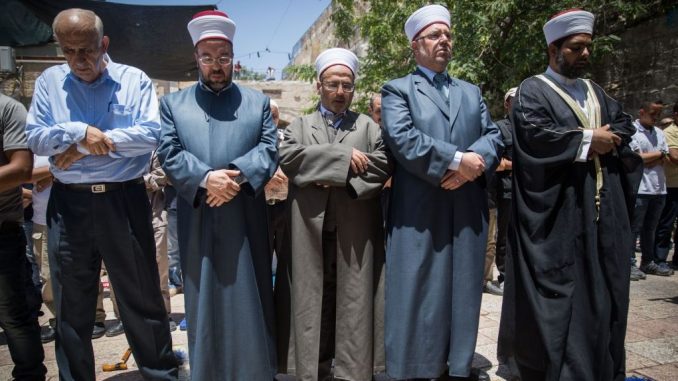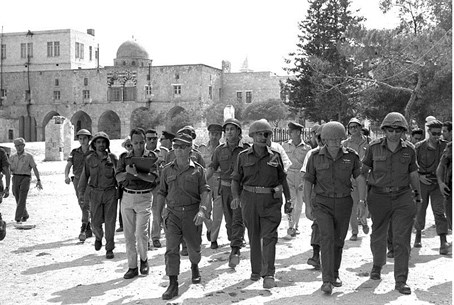Jordan lost control of Jerusalem in 1967, but is now at the heart of a crisis that threatens to plunge the city into violence
By DOV LIEBER, TOI July 20, 2017,

As tensions ratchet up in Jerusalem’s Old City following Israel’s installation of metal detectors at gates to the Temple Mount in response to a terror attack there, attention has turned to the byzantine warren of authorities that control and manage the ultra-sensitive holy site.
While Israel controls access to the compound, inside its nine gates the Jerusalem Awqaf Department — sometimes called the Islamic Religious Endowments Authority, or simply the Waqf — exerts near total control.
The Waqf is entirely controlled and funded by the Jordanian government. It administers daily life on the Temple Mount, which includes the Al-Aqsa Mosque, Dome of the Rock, archaeological sites, museums and schools.
Since Israel captured the site in 1967, an uneasy relationship between authorities and the Waqf has been maintained, with both saying they are committed to keeping the delicate status quo that allows non-Muslims to visit, but not worship, on the Mount.
For many non-Muslims, both the Waqf and the status quo remain a mystery, and questions abound as to how the body has come to wield such power in a city that is ostensibly completely under the control of the state of Israel.
Flexing their muscles
The Temple Mount is the holiest site in Judaism, the place where the two ancient Jewish Temples stood. It is considered the third holiest site in Islam, the spot where the prophet Mohammed ascended to heaven.
Ever-present acrimony between Israeli officials and the Waqf have come to a head since July 14, when three Arab-Israeli men opened fire on policemen guarding just outside the holy site, killing two. According to Israeli authorities, the trio stashed their guns in the Temple Mount and Israel quickly closed access to the site — the first time in decades it was shuttered on a Friday — leading to outcry from Muslims around the world. On Thursday, police release video footage showing how the guns were smuggled into the holy site.
When it reopened on Sunday, police had installed metal detectors at two of the gates, and other gates were closed. Arab officials have criticized the measure as breaking the status quo — and part of an alleged process of a slow takeover by Israel of the site — and the Waqf has refused to enter the site, encouraging other Muslims to boycott as well, leading to protest prayers outside the gates that have devolved into near-daily clashes.
Israel argues the security measures are necessary in the wake of Friday’s “defiling” of the site by the killers, to ensure such shooting attacks do not occur at the sensitive holy site in the future.
The ensuing standoff has threatened to plunge the tinderbox city back into the throes of violence. Israel and Jordan are reportedly in talks to come up with a compromise agreement, but in the meantime both the Israeli authorities and Waqf officials are holding to their positions — Israel is not removing the metal detectors, and the Waqf is discouraging worshipers from entering the compound so long as they remain.
So what’s a waqf anyway?
To understand the purpose of the institution known as the Jerusalem Waqf, it helps to know what a waqf is.
In Islamic law, a person may decide to donate a property and its revenues to the public for charitable or religious purposes. This property then becomes a waqf, or holding, in perpetuity.
Examples of waqfs (awqaf is the Arabic plural) can be homes, fields, water reservoirs, schools, orphanages and mosques.
In Israel, the best known waqf property is the Temple Mount, known to Muslims as the Haram al-Sharif. For Muslims, the entire esplanade is considered a mosque.
As the modern state grew in the Middle East through 19th and 20th centuries, these properties were taken under the authority of governments.

Until 1917, waqf properties in Jerusalem were controlled by the Ottoman Empire.
During the British Mandate period, responsibility for the awqaf was put under the control of the Supreme Muslim Council—the body of Palestinian Muslims appointed by the British colonial government to administer the Sharia courts and awqaf.
In 1948, when the Hashemite Kingdom of Jordan took over the West Bank and East Jerusalem, it transferred responsibility for the city’s awqaf, including the Temple Mount compound, to its own ministry of awqaf.
When Israel conquered East Jerusalem in 1967, then defense minister Moshe Dayan decided it would be best if the Jordanian Awqaf Ministry would continue to administer the site, in order to avoid a larger conflagration with the Muslim world. Jews would be allowed to visit, but not to pray, he decided — utilizing the rabbinical consensus in Jewish religious law that Jews should not set foot atop the Mount for fear of defiling the temples’ most sacred space, the Holy of Holies.
From then on, it was agreed that Israel would be responsible for security around the perimeter of the site, while the Jordanian-controlled Jerusalem Waqf would be responsible for what happens within the compound.
This situation continued informally until 1994, when Israel and Jordan signed a peace treaty.
Article 9 of the treaty states:
“Israel respects the present special role of the Hashemite Kingdom of Jordan in Muslim Holy shrines in Jerusalem. When negotiations on the permanent status will take place, Israel will give high priority to the Jordanian historic role in these shrines.”
Jordan officially separated from the West Bank in 1988, in order to allow for Palestinian leadership to take over, but not from East Jerusalem.
Jordan argued it would not allow a “protection gap” of Islamic holy sites in Jerusalem while the PLO and Israel were in negotiations over the future of the city.
Up until 1994, the grand muftis of Jerusalem—who are considered the leading religious figures for Palestinians—were appointed by Jordan. But in a deal with the PLO, the role was transferred to Palestinian leadership that year.
The current Grand Mufti of Jerusalem, Muhammad Hussein, who has played a central role in opposing Israeli measures since the shooting attack on Friday, was appointed by Palestinian Authority President Mahmoud Abbas in 2006, and his salary is paid by the PA.
Jordan also considers itself to have a special historical relationship with Jerusalem, especially Al-Aqsa Mosque, since the time of the British Mandate.
While the Supreme Muslim Council (SMC) was in charge of administering the site, the then ruler of Mecca and leader of the revolt against the Ottoman Empire Hussein ibn Ali al-Hashimi, whose son became the first king of Jordan, was accepted as its custodian by the SMC leadership. This custodianship has been passed down by to subsequent Jordanian kings.
From 1921 to 2010, the Royal Jordanian Hashemite family spent over $1 billion on maintaining the Awqaf administration, according to the a report by independent Royal Islamic Strategic Studies Centre, located in Amman.
A senior official the Jerusalem Waqf told the Times of Israel it currently employs 900 people.
Today, the Jerusalem Waqf controls not only the Temple Mount, but also schools, orphanages, Islamic libraries and museums, mosques, the Sharia courts and many residential and commercial properties across the city of Jerusalem.






The Temple Mount should be No Go zone for fanatics.